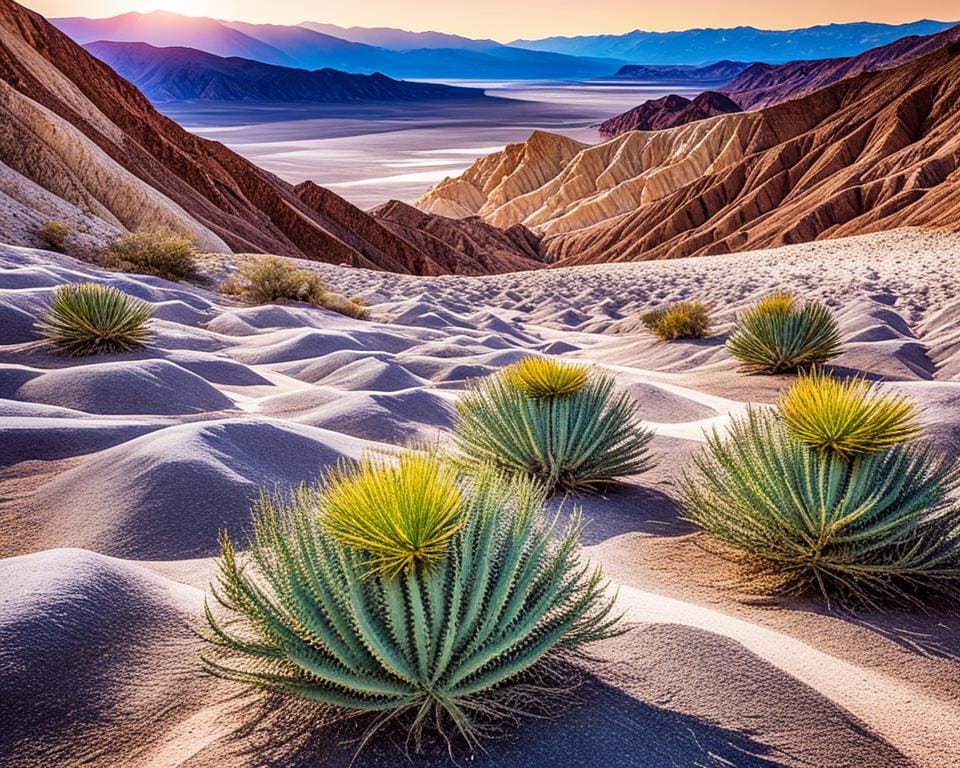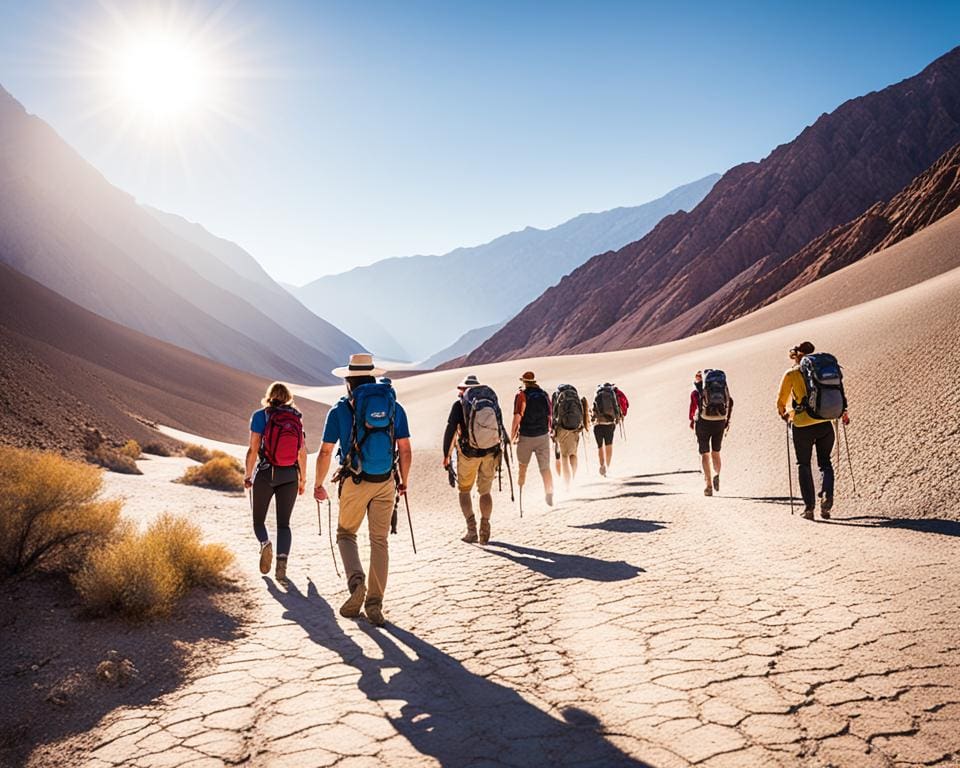Welcome to Death Valley, a place of extreme beauty and challenge. It’s in California’s Mojave Desert. It holds the record for the highest temperature ever at 134°F (56.7°C). More than a million people visit each year. They come for the adventure and stunning views. The valley has Badwater Basin, the lowest point in North America. Plus, there are rugged mountains around the valley floor. It’s a must-see for every kind of traveler.
In Death Valley National Park, get ready for some heat. Temperatures often hit 120°F (49°C) in summer. But, you’ll find many things to do, like hiking and taking photos. You’ll see amazing geological formations. Death Valley is more than just a hot place. It’s about survival, resilience, and wonder. It attracts adventurers from all over the world.
Unraveling the Extreme Climate of Death Valley
Death Valley is known for its extreme climate. It has high temperatures and very little rain, making it one of the harshest places on Earth. Nearly one million tourists visit every year. They come to see how this unique place affects its weather.
Understanding Death Valley’s Record Temperatures
The highest temperature recorded in Death Valley was 134°F at Furnace Creek. During summer, it’s often hotter than 120°F. In the summer of 2001, the temperature was over 100°F for 154 days in a row. This makes Death Valley one of the hottest places in the world.
What Makes Death Valley So Dry?
Death Valley is very dry because of the rainshadow effect. Four big mountain ranges catch moisture from the Pacific Ocean. This leaves Death Valley without much rain. It gets less than 2 inches of rain a year, making it the driest place in North America. In 1929 and 1953, it didn’t rain at all.
The Unique Geography of the Valley
The geography of Death Valley makes its climate extreme. It’s a long, narrow basin below sea level, surrounded by high mountains. The sun heats it up, and the valley traps the heat, making it even hotter. The different landscapes, like sand dunes and salt flats, are beautiful. They attract those who want to learn about this extreme heat place.

Death Valley: Exploring the Hottest Place on Earth
Death Valley’s history and life are incredibly rich and fascinating. It was first the home of the Timbisha tribe, thriving here for centuries. During the 1849 California Gold Rush, Europeans arrived, facing tough conditions. This gave Death Valley its dark name. Yet, the Timbisha tribe got 7,500 acres of their land back, keeping their culture alive in this stunning area.
Life and History in Death Valley
Today, about 576 people live in Death Valley. They work to maintain the national park and offer services to visitors. The park is huge, covering 3.4 million acres, and is the biggest in the lower 48 states. Life here is shaped by extreme heat and very little rain, affecting both plants, animals, and human activities.
Key Attractions in Death Valley National Park
The sights in Death Valley are diverse and stunning. Don’t miss must-see spots in Death Valley, like Badwater Basin. It’s the lowest point in North America, 282 feet below sea level. The view is amazing, with tall mountains around the valley. For adventure lovers, Death Valley has hiking trails for all, from easy walks to tough hikes.
Don’t forget Mesquite Flat Sand Dunes and Zabriskie Point. These places offer beautiful landscapes and unique formations. Dante’s Peak gives incredible views, showing off the park’s varied landscape. Visiting these spots helps people see Death Valley’s beauty and unique history, making it a wonder amid harsh conditions.
Essential Travel Tips for Visiting Death Valley
When you plan your trip to Death Valley National Park, drinking enough water is key. The park’s temperatures often hit 120 degrees in the summer. This can quickly lead to heat illnesses. Make sure to bring a lot of water and a bottle you can refill. The cooler months from November to March are the best times to visit. During these months, the weather is nicer for exploring.
Don’t forget to pack things like sunscreen, good shoes, and food for snacks. Death Valley is huge, so you need to plan where to stay and how long to get from one place to another. There aren’t many places to get gas, so fill your tank early. Also, keep in mind the drive from cities like Las Vegas or Los Angeles. It can take about two or four-and-a-half hours.
Exploring the park offers breathtaking views, especially during sunrise and sunset at spots like Zabriskie Point and the sand dunes. But remember, cellphone service isn’t reliable. Be careful of sudden floods if it rains, especially in narrow valleys. Following these tips will help you have a safe and unforgettable journey. Death Valley is truly one of the most amazing places on the planet.









